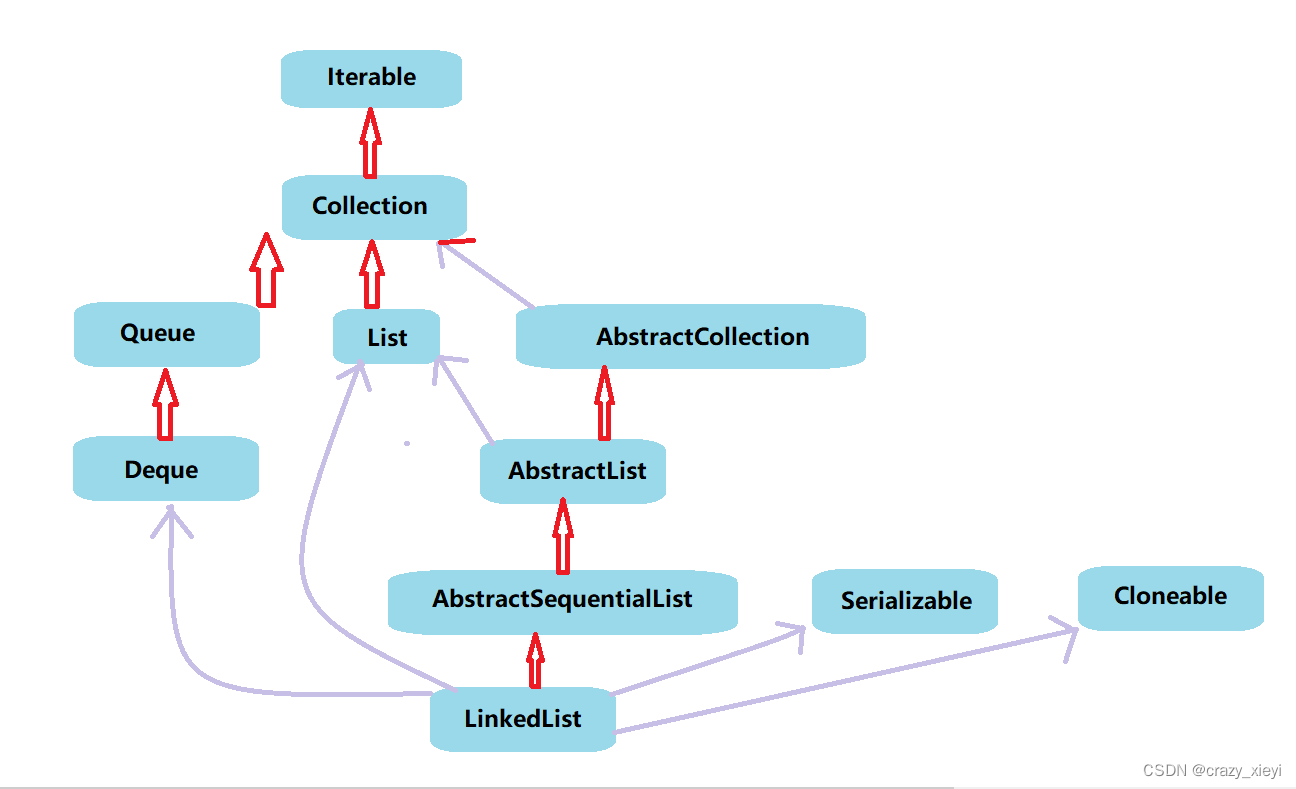文章目录
- 一、什么是LinkedList?
- 二、LinkedList的使用
- 三、LinkedList自实现
- 四、链表实现逆序打印的两种方式(递归和非递归)
-
五、ArrayList和LinkedList有什么区别?
一、什么是LinkedList?
LinkedList
的底层是双向链表结构
(
链表后面介绍
)
,由于链表没有将元素存储在连续的空间中,元素存储在单独的节点中,然后通过引用将节点连接起来了,因此在在任意位置插入或者删除元素时,不需要搬移元素,效率比较高。
在集合框架中,
LinkedList
也实现了
List
接口,具体如下:

1. LinkedList
实现了
List接口
2. LinkedList
的底层使用了双向链表
3. LinkedList
没有实现
RandomAccess
接口,因此
LinkedList
不支持随机访问
4. LinkedList
的任意位置插入和删除元素时效率比较高,时间复杂度为
O(1)
二、LinkedList的使用
构造方法:
| 方法 | 解释 |
|
LinkedList
()
|
无参构造
|
|
public LinkedList(Collection<? extends E> c)
|
使用其他集合容器中元素构造
List
|
public static void main(String[] args) {
// 构造一个空的LinkedList
List<Integer> list1 = new LinkedList<>();
List<String> list2 = new java.util.ArrayList<>();
list2.add("JavaSE");
list2.add("JavaWeb");
list2.add("JavaEE");
// 使用ArrayList构造LinkedList
List<String> list3 = new LinkedList<>(list2);
}LinkedList的常用方法:
| 方法 | 解释 |
|
boolean
add
(E e)
|
尾插
e
|
|
void
add
(int index, E element)
|
将
e
插入到
index
位置
|
|
boolean
addAll
(Collection<? extends E> c)
|
尾插
c
中的元素
|
|
E
remove
(int index)
|
删除
index
位置元素
|
|
boolean
remove
(Object o)
|
删除遇到的第一个
o
|
|
E
get
(int index)
|
获取下标
index
位置元素
|
|
E
set
(int index, E element)
|
将下标
index
位置元素设置为
element
|
|
void
clear
()
|
清空
|
|
boolean
contains
(Object o)
|
判断
o
是否在线性表中
|
|
int
indexOf
(Object o)
|
返回第一个
o
所在下标
|
|
int
lastIndexOf
(Object o)
|
返回最后一个
o
的下标
|
|
List<E>
subList
(int fromIndex, int toIndex)
|
截取部分
list
|
LinkedList的遍历:(foreach遍历、使用迭代器遍历---正向遍历、使用反向迭代器---反向遍历
LinkedList<String> list = new LinkedList<>();
list.add("javaSE");
list.add("javaWeb");
list.add("javaEE");
// foreach遍历
for (String x: list) {
System.out.print(x + " ");
}
// 使用迭代器遍历---正向遍历
ListIterator<String> list1 = list.listIterator();
while (list1.hasNext()){
System.out.print(list1.next()+" ");
}
// 使用反向迭代器---反向遍历
ListIterator<String> lis2 = list.listIterator(list.size());
while (lis2.hasPrevious()){
System.out.print(lis2.previous()+" ");
}三、LinkedList自实现
public class MyLinkedList {
static class ListNode{
int val;
ListNode pre;
ListNode next;
public ListNode(int val){
this.val = val;
}
}
public ListNode head;//头部
public ListNode tail;//尾部
public void addFirst(int data){
ListNode node = new ListNode(data);
if (head == null){
head = node;
tail = node;
return;
}
node.next = head;
head.pre = node;
head = node;
}
public void addLast(int data){
ListNode node = new ListNode(data);
if (head == null){
head = node;
tail = node;
return;
}
tail.next = node;
node.pre = tail;
tail = node;
}
//任意位置插入,第一个数据节点为0号下标
public boolean addIndex(int index,int data){
if (index < 0 || index > size()){
System.out.println("index位置不合法!");
return false;
}
if (index == 0){
addFirst(data);
return true;
}
if (index == size()){
addLast(data);
return true;
}
ListNode indexNode = findNode(index);
ListNode node = new ListNode(data);
node.pre = indexNode.pre;
indexNode.pre.next = node;
node.next = indexNode;
indexNode.pre = node;
return true;
}
public ListNode findNode(int index){
ListNode cur = head;
while (index != 0){
cur = cur.next;
index--;
}
return cur;
}
public boolean contains(int key){
ListNode cur = head;
while (cur != null){
if (cur.val == key)return true;
cur = cur.next;
}
return false;
}
public void remove(int key) {
ListNode cur = head;
while (cur != null) {
if (cur.val == key) {
if (cur == head) {
head = head.next;
if (head != null) {
head.pre = null;
} else {
tail = null;
}
} else {
cur.pre.next = cur.next;
if (cur.next != null) {
cur.next.pre = cur.pre;
} else {
tail = tail.pre;
}
}
return;
}
cur = cur.next;
}
}
public void removeAllKey(int key) {
ListNode cur = head;
while (cur != null) {
if (cur.val == key) {
if (cur == head) {
head = head.next;
if (head != null) {
head.pre = null;
} else {
tail = null;
}
} else {
cur.pre.next = cur.next;
if (cur.next != null) {
cur.next.pre = cur.pre;
} else {
tail = tail.pre;
}
}
}
cur = cur.next;
}
}
public int size(){
ListNode cur = head;
int count = 0;
while (cur != null){
count++;
cur = cur.next;
}
return count;
}
public void display(){
ListNode cur = head;
while (cur != null){
System.out.print(cur.val + " ");
cur = cur.next;
}
}
public void clear(){
ListNode cur = head;
while (cur != null){
ListNode temp = cur.next;
cur.next = null;
cur.pre = null;
cur = temp;
}
head = null;
tail = null;
}
}
四、链表实现逆序打印的两种方式(递归和非递归)
递归逆序打印:
public void display(ListNode head) {
if(head == null) {
return;
}
if(head.next == null) {
System.out.print(head.val+" ");
return;
}
display(head.next);
System.out.print(head.val+" ");
}非递归逆序打印(用栈实现):
public void display(ListNode head) {
if (head == null) {
return;
}
Stack<ListNode> stack = new Stack<>();
ListNode cur = head;
while (cur != null) {
stack.push(cur);
cur = cur.next;
}
while (!stack.empty()) {
ListNode ret = stack.pop();
System.out.print(ret.val+" ");
}
}五、ArrayList和LinkedList有什么区别?
ArrayList实质是顺序表,底层是一个数组。LinkedList实质是一个链表。
他们都具有增删查改的功能,但是在实现方式上有区别。比如在插入元素的时候,ArrayList往0位置上插入一个元素,就需把整个数组整体往后移动,时间复杂度为O(N)。而LinkedList只需要修改指向就可以了,时间复杂度为O(1)。但是ArrayList可以支持随机访问,时间复杂度为O(1),所以一般情况下ArrayList顺序表适合频繁根据下标位置访问,LinkedList比较适合插入和删除比较频繁的情况。
从存储上来说,ArrayList顺序表在物理上和逻辑上都是连续的,但是在扩容的时候,可能会造成空间的浪费。而LinkedList在物理上不一定是连续的,在逻辑上是连续的,可以做到随用随取。
| 不同点 | ArrayList | LinkedList |
|
存储空间上
|
物理上逻辑上一定连续
|
逻辑上连续,但物理上不一定连续
|
|
随机访问
|
支持
O(1)
|
不支持:
O(N)
|
|
头插
|
需要搬移元素,效率低
O(N)
|
只需修改引用的指向,时间复杂度为
O(1)
|
|
插入
|
空间不够时需要扩容
|
没有容量的概念
|
|
应用场景
|
元素高效存储
+
频繁访问
|
任意位置插入和删除频繁
|